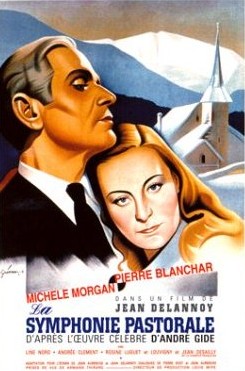- La symphonie pastorale
Infobox Film | name = La symphonie pastorale

image_size=175px
caption =film poster
director =Jean Delannoy
producer =
writer = André Gide (novel)
starring =Pierre Blanchar Michèle Morgan
music =
cinematography =
editing =
distributor = Pathé Consortium Cinéma
released = September 1946 (Cannes Film Festival )
runtime = 110 min
language = French
budget =
imdb_id = 0039004"La symphonie pastorale" is a 1946
French language motion picture drama directed byJean Delannoy and starringMichèle Morgan and Pierre Blanchar.The film is based on the novella "
La Symphonie Pastorale " byAndré Gide and adapted to the screen by Jean Aurenche. The film score was byGeorges Auric . At theCannes Film Festival , it won the "Grand Prix" (equivalent of theGolden Palm ) and the Best Actress award for Michèle Morgan.Plot Summary
The
pastor of amountain village adopts a small blind girl, Gertrude. As Gertrude grows up into an attractive young woman, the pastor, now middle-aged, realises that he is in love with her. To his chagrin, his adopted son, Jacques, is also in love with Gertrude, even though he is shortly to be married to another woman.Jacques’s fiancée is jealous of Gertrude and arranges for her to see a doctor in the hope that she might be cured and to enable Jacques to choose equally between the two women.
Miraculously, Gertrude’s sight is restored and she returns to the village a changed woman. Unable to accept Jacques’s love and disappointed by the pastor’s affections for her, she realises that her former happiness has been lost forever.
This film supports an alternative reading, which supplies a second, deeper meaning. The blind girl comes to dominate the pastor’s consciousness as he guides her from being the brutish creature seen in our first glimpse of her, into an accomplished and attractive young woman. His obsession with her damages his family life. There is no indication of carnal attraction between the pastor and her; she is his spiritual creation. This alternative interpretation, then, is that the blind girl is a kind of demon (as suggested by her first appearance) who takes over his consciousness, with the result of wrecking his family life and marring his surface saintliness. This meaning is cued for us by his wife’s slowly growing worry. In the cinema generally demons are usually represented as grotesques and are not shown as attractive. The genius of this film is to inform us why demons might indeed be dangerous. Michelle Morgan has an eery beauty that helps mediate this reading, and she was likely cast here in part for that reason. This interpretation, given the Huguenot context, places the tale in the long line of Christian temptation stories.
External links
*
Wikimedia Foundation. 2010.
